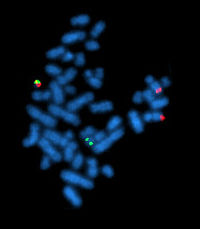
Photo from wikipedia
Background: Synovial sarcoma (SS) is an aggressive, but a relatively chemosensitive soft tissue sarcoma, characterized by a specific, t (X;18)(p11;q11) translocation, leading to formation of SS18–SSX chimeric transcript. This translocation… Click to show full abstract
Background: Synovial sarcoma (SS) is an aggressive, but a relatively chemosensitive soft tissue sarcoma, characterized by a specific, t (X;18)(p11;q11) translocation, leading to formation of SS18–SSX chimeric transcript. This translocation can be detected by various techniques, such as fluorescence in-situ hybridization (FISH), reverse transcriptase PCR (RT-PCR) and fragment analysis. Objectives: To compare the results of detection of t (X;18)(p11;q11) translocation, across three different platforms, in order to determine the most optimal and sensitive technique. Methods: Formalin-fixed paraffin embedded (FFPE) tissue sections of 45 soft tissue sarcomas were analyzed, including 16 cases of SS confirmed by histopathology, immunohistochemistry and molecular technique (s)(Group 1); 13 cases, wherein SS was one of the differential diagnosis, preceding molecular testing (Group 2) and 16 cases of various other sarcomas (Group 3). Various immunohistochemical (IHC) markers studied, including INI1/SMARCB1. All cases were tested for t (X;18) translocation, by fragment Analysis, FISH and RT-PCR. Results: There were 23 cases of SS, including 16 of group 1 and 7 of group 2. By fragment analysis, t (X;18)(p11;q11) translocation was detected in 22/23 cases (95.6%). By FISH, SS18 gene rearrangement was detected in 18/22 cases (78.2%), whereas by RT-PCR, SS18-SSX transcripts were detected in 15/23 cases (65.2%). Immunohistochemically, a unique “weak to absent”/reduced INI1 immunostaining pattern was exclusively observed in 12/13 cases of SS (92.3%). Fragment analysis and FISH were relatively more sensitive techniques. Unique “weak to absent”INI1 immunoexpression significantly correlated with positive t (X;18) translocation results (P = 0.0001). Conclusion: The present study constitutes first such study from our subcontinent. Fragment analysis is a promising technique for detection of t (X;18)(p11;q11) translocation. FISH and INI1 immunostaining pattern were also relatively more sensitive, over RT-PCR.
Journal Title: Indian Journal of Pathology and Microbiology
Year Published: 2020
Link to full text (if available)
Share on Social Media: Sign Up to like & get
recommendations!